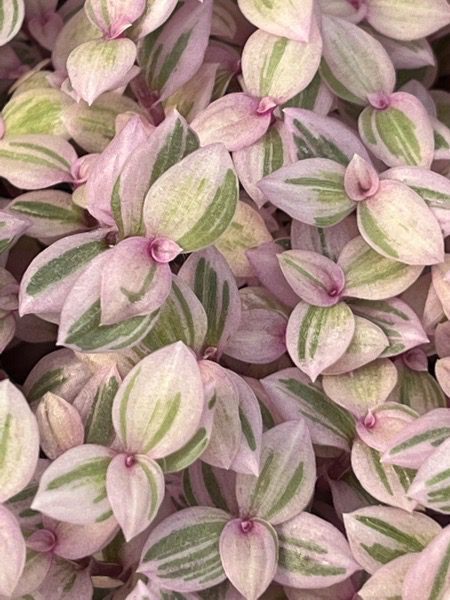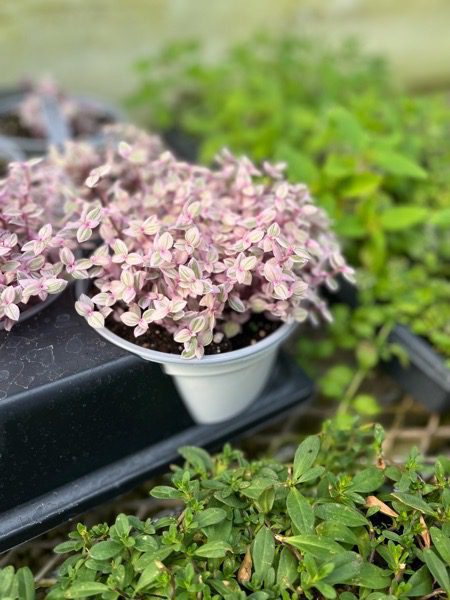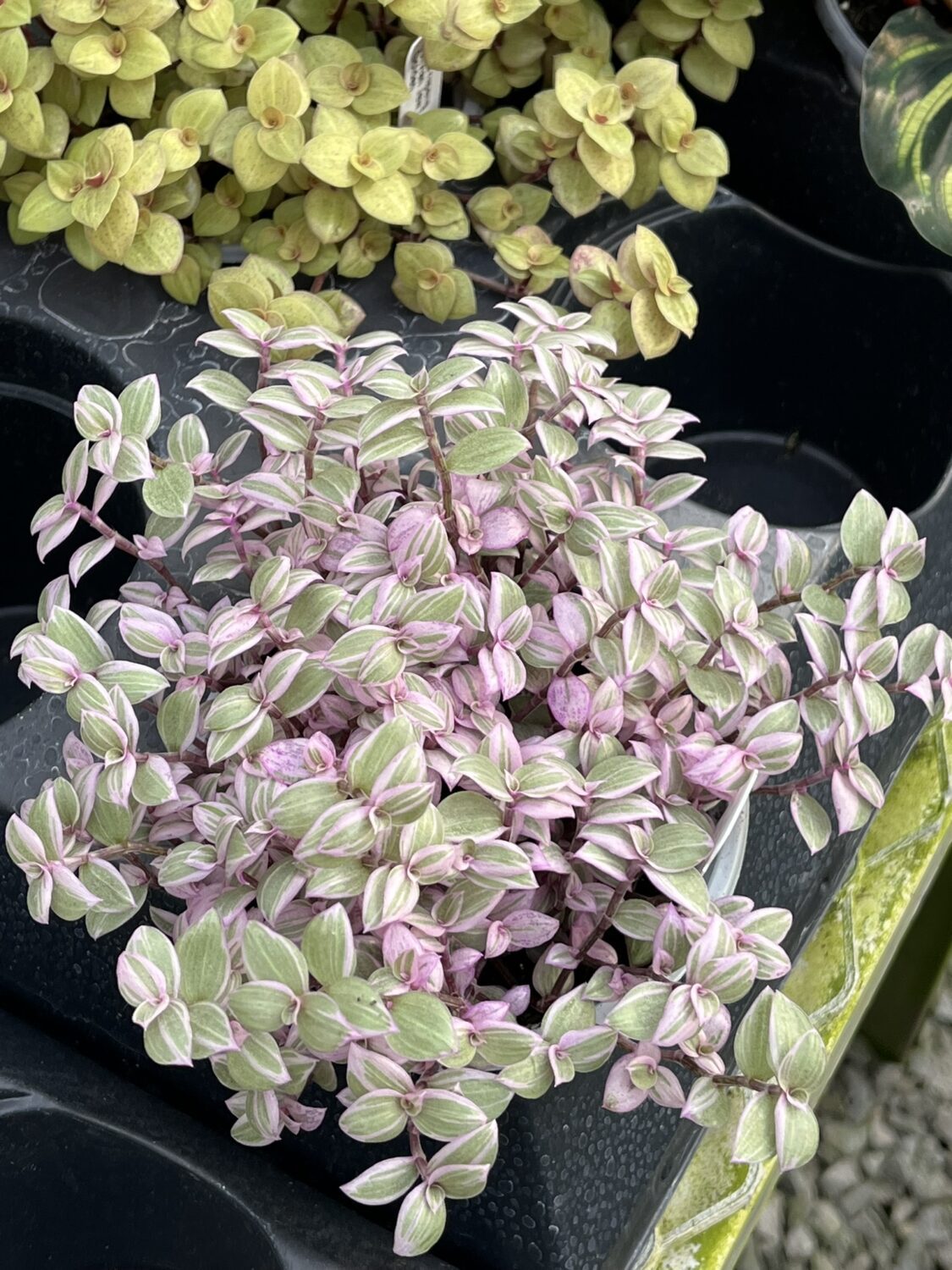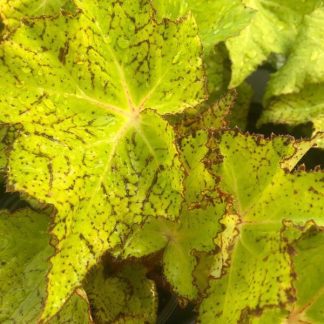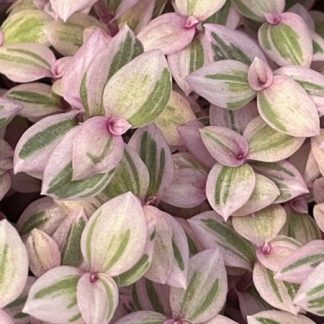Description
Callisia repens ‘Bolivian Jew Pink’: A Tiny Trail of Cheer
A Friendly Welcome
Walk into any bright room and set down a pot of Callisia repens ‘Bolivian Jew Pink.’ You will see smiles bloom right away. The plant trails over the rim, each stem tipped with candy-striped leaves of rose, mint, and cream. It stays small, yet it shines loud. In other words, it is color and charm in a cup-size package. In this deep dive we explore what makes this plant special, how to help it thrive, and why it fits almost every home. Let’s wander together down its pink path.
Meet the Plant
Many Names, One Heart
People love to give nicknames. You may hear Bolivian Jew, Turtle Vine, Pink Panther, or Chain Plant. All point to the same creeping wonder: Callisia repens, a cousin of Tradescantia. The word repens means “creeping,” which tells us how the stems behave. They crawl, root where they touch, and form soft carpets.
A Burst of Color
Most wild forms wear plain green. The ‘Pink’ form, however, paints itself with blush tones. Each leaf is a tiny oval, no longer than your pinkie nail. The top side shows stripes of dusty rose, jade, and ivory. The underside wears solid pink. When light filters through the leaves you see the colors glow like stained glass.
Size and Shape
- Mature length: 12–24 inches (trailing)
- Leaf size: ½–¾ inch
- Habit: Low, cascading mat
Because it stays shallow, you can grow it in small pots, wall planters, or even fairy-garden dishes.
How ‘Bolivian Jew Pink’ Grows
Native Clues
In nature, Callisia creeps along rocky hillsides in Central and South America. It hides under shrubs, catching dappled light and quick rain. These clues guide our care: bright shade, warm air, and brief dry spells.
Growth Rhythm
Spring and summer bring the fastest spread. New shoots race outward, and you may spot tiny white blooms. Fall slows growth, and winter sends the plant to rest. Even then, the leaves hold their color if they get enough light.
Choosing the Right Spot
Light
- Bright, indirect sun gives the best pink.
- A little morning sun boosts color.
- Midday scorch, however, can crisp the leaves.
If your window faces south or west, pull the pot two feet back or use a sheer curtain. In dim rooms the pink fades to green; move the plant closer to light and it will blush again within weeks.
Temperature
Keep the air between 60–85 °F. Drafts below 55 °F stunt growth and may drop leaves. Outdoor summers are fine, yet bring the plant inside before nights dip under 55 °F.
Humidity
Callisia loves gentle moisture in the air, about 40–60 %. Normal home humidity works, but heating vents can dry tips. Place the pot on a pebble tray or group with other plants to share humidity.
Potting Mix and Repotting
Soil Recipe
We want quick flow yet steady moisture. Mix:
- 2 parts quality houseplant potting soil
- 1 part perlite
- 1 part fine orchid bark or coco coir chips
This blend keeps roots airy while holding drops between waterings.
Pot Choice
A shallow ceramic bowl, nursery pot, or hanging basket all work if drainage holes are present. Roots stay compact, so you only need to repot every 12–18 months. Move up one size when the stems crowd the rim and water runs right through.
Watering Wisdom
Feel, Don’t Guess
Push a finger into the top inch of mix. If it feels dry, water. If cool and damp, wait a day. In bright, warm months you may water twice a week. In cooler seasons once a week or less is enough.
Technique
Pour water until it streams from the bottom. Empty any saucer after ten minutes. This plant hates soggy feet; standing water invites rot.
Signs of Trouble
- Shriveled leaves: too dry.
- Yellow, limp leaves: too wet.
- Faded pink: low light or constant dampness.
Feeding for Happy Hues
During active growth (March–September) feed every four weeks with a half-strength balanced liquid fertilizer. Too much food pushes green growth and can dull pink tones, so stay light. In winter, skip feeding.
Pruning and Training
Snip for Shape
Leggy stems? Simply pinch back the tips. Each cut wakes two side shoots, thickening the mat. Save the cuttings for new plants.
Creative Displays
- Let stems tumble from a macramé hanger.
- Tuck cuttings around the rim of a taller plant as living mulch.
- Weave strands through a mini trellis for a soft pink lattice.
Propagation Made Simple
- Clip a 3-inch stem below a node.
- Strip the bottom leaves.
- Lay the cutting on damp mix, node touching soil.
- Mist daily until new leaves appear (about two weeks).
Roots sprout fast, so you can fill gaps or share with friends in no time.
Overwintering and Frost Care
If you summer the plant outdoors, move it inside well before first frost. A sudden chill may darken leaves. Place it near a bright window and reduce water while growth slows. Resume normal care when daylight lengthens.
Common Problems and Simple Fixes
| Issue | Signs | Cause | Solution |
|---|---|---|---|
| Leaf scorch | Brown edges | Too much direct sun | Shift to filtered light |
| Root rot | Mushy stems, foul smell | Waterlogged soil | Trim rot, repot in fresh mix |
| Mealybugs | White cotton spots | Low airflow | Dab with alcohol, rinse plant |
| Aphids | Sticky leaves | Fresh outdoor growth | Spray with soapy water |
Stay watchful; early action keeps problems small.
Styling Ideas Indoors and Out
Indoors
- Bookshelf Splash: Place a small pot on the edge of a shelf. Stems drape like ribbons between books.
- Table Centerpiece: Combine with a white pot to make pink tones pop during brunch.
- Terrarium Accent: Use cuttings in an open terrarium for a soft groundcover.
Outdoors
- Patio Basket: Mix with chartreuse sweet potato vine for a neon duo.
- Rock Garden Crevice: Tuck into a crack where other plants fail; its creeping habit fills gaps.
- Fairy Garden Carpet: Children love the tiny leaves and candy colors.
Remember to bring it inside before cold nights.
Pet Safety Note
Callisia may cause mild skin redness or stomach upset if pets chew heavily. Keep curious cats from grazing. Offer safe grass for them instead.
Quick Reference Cheat Sheet
- Light: Bright, indirect; some morning sun
- Water: Dry top inch, then soak
- Soil: Fast-draining, airy
- Temp: 60–85 °F, frost-free
- Humidity: Average home or higher
- Fertilizer: Half-strength monthly, spring to fall
- Prune: Pinch often to thicken
- Propagate: Stem cuttings, easy and quick
Tape this near the pot for an instant reminder.
Why We Fall in Love Again and Again
After more than one glance, you notice how the plant changes with the day. Morning sun warms the pinks; evening shade cools them. When you snip a strand, new growth appears almost overnight, reminding us how life keeps moving. Instead of standing tall and stiff, Bolivian Jew Pink sprawls, shares space, and invites us to relax. It teaches that beauty can be small, soft, and close to the ground. Most of all, it asks little but gives plenty.
Growing Together Into Tomorrow
We have walked through every corner of care: light, water, soil, feeding, and more. Now the next step is yours. Find a bright spot, mix a light soil, and welcome this pink friend into your day. As weeks pass, you will trim, root, and share pieces with neighbors. Soon many windows will glow with tiny pink flags of joy. So let us roll up our sleeves, lift that first pot, and start the journey.

